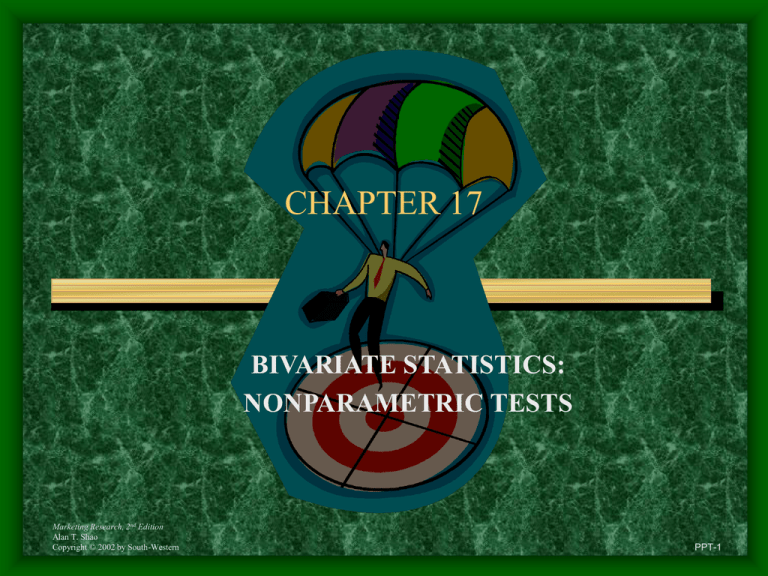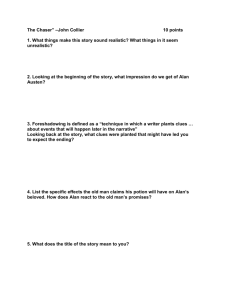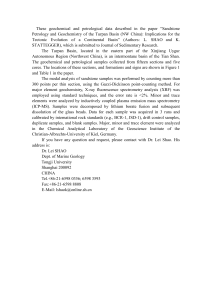chapter 7 - courses.psu.edu
advertisement

CHAPTER 17 BIVARIATE STATISTICS: NONPARAMETRIC TESTS Marketing Research, 2nd Edition Alan T. Shao Copyright © 2002 by South-Western PPT-1 What The Experts Say A parametric procedure is an exact solution to an approximate problem, whereas a nonparametric procedure is an approximate solution to an exact problem. --Amir D. Aczel, Complete Business Statistics (Homewood, Ill.: Irwin/McGraw-Hill, 1999). Marketing Research, 2nd Edition Alan T. Shao Copyright © 2002 by South-Western PPT-2 Learning Objectives • Explain the use of various nonparametric tests • Run various nonparametric tests • Interpret the results obtained from nonparametric tests Marketing Research, 2nd Edition Alan T. Shao Copyright © 2002 by South-Western PPT-3 Get This! Does Color Matter? • Officials in the U.S. government responsible for several million questionnaires every year have reported that yellow paper produces the highest percentage of returns, with pink next in effectiveness • Francis Buttle, a professor of marketing at Cranfield University in the United Kingdom, and Gavin Thomas, an independent marketing research consultant, were not convinced that color makes a difference • They conducted an experiment as part of a large survey into the perceived cost and benefits of ISO 9000 in certified organizations. Marketing Research, 2nd Edition Alan T. Shao Copyright © 2002 by South-Western PPT-4 Get This! Does Color Matter? – cont’d • The experiment was designed to evaluate whether yellow-colored paper stock produced a significantly different response rate than white. • More white questionnaires (29.32%) were returned than yellow (28.24%). The researchers used a statistical technique called “chi-square test of significance” to analyze the data. They concluded that the difference in response rates between yellow and white returns was not significant. Marketing Research, 2nd Edition Alan T. Shao Copyright © 2002 by South-Western PPT-5 Now Ask Yourself • Do you think paper color matters when it comes to deciding whether or not a questionnaire will be completed and mailed back to the researcher? • Do you think the chi-square test of significance was really necessary to generate the findings? Why or why not? • Could the Internet have been used to conduct a similar study? Why or why not? Marketing Research, 2nd Edition Alan T. Shao Copyright © 2002 by South-Western PPT-6 Nonparametric Tests • Nonparametric methods of testing hypotheses are • • • • not concerned with particular population parameters. We do not have to know the shape of the population or make assumptions for the purpose of testing hypotheses. They have relatively easy computations and are relatively easy to understand. They can be used with ranked information and for tests involving small samples sizes. Their applications are limited to certain types of information. Marketing Research, 2nd Edition Alan T. Shao Copyright © 2002 by South-Western PPT-7 Nonparametric Tests – cont’d • They tend to be less precise and efficient than parametric methods. • They can be used in any of the following situations: – When the population distribution from which the sample is drawn cannot be assumed to be normal. – When the sampling distribution is known not to be normal. – When nonmetric (nominal- or ordinal-scaled) data are used. Marketing Research, 2nd Edition Alan T. Shao Copyright © 2002 by South-Western PPT-8 Contingency Tables – Chi-Square Test of Independence • A contingency table or cross-tabulation table is a statistical table in which row entries classify data according to one variable and column entries classify data according to another variable. When there are r rows and c columns in theΧtable, it is called an r x c contingency table. – The frequencies in the cells are called cell frequencies. – The total of the frequencies in each row or each column is called the marginal frequency. – The same formula used to explain the goodness-offit test can be used to compute the value of 2. Marketing Research, 2nd Edition Alan T. Shao Copyright © 2002 by South-Western PPT-9 Contingency Tables – Chi-Square Test of Independence – cont’d (Oi Ei ) 2 Ei i 1 k 2 where Oi = observed frequency in cell i E i = expected or theoretical frequency in cell i k = number of mutually exclusive categories The number of degrees of freedom of an r x c contingency table is (r - 1)(c - 1). Contingency tables may be constructed in various ways. Sometimes they simply show the numbers of elements in each cell. Other times, raw percentages are provided in each cell. Marketing Research, 2nd Edition Alan T. Shao Copyright © 2002 by South-Western PPT-10 Rank-Sum Tests Use some sort of ranking totals in their calculations • Wilcoxon Test • Mann-Whitney (U) Test • Kruskal-Wallis (H) Test Marketing Research, 2nd Edition Alan T. Shao Copyright © 2002 by South-Western PPT-11 Wilcoxon Test for Matched Pairs a.k.a., the signed-rank test Analyzes ordinal data for differences between two related samples by using plus and minus signs and considers both the magnitudes of the differences and ranks of the differences between the paired values. – Test is used when there is a natural way to pair data. – Test works well for before and after data to test for a median difference of zero. – Test can take the place of a one-sample t-test when we cannot assume a normal distribution. – Purpose of the test is to decide whether the difference between a computed signed-rank sum and the expected rank sum of the same sign is large enough to be significant. Marketing Research, 2nd Edition Alan T. Shao Copyright © 2002 by South-Western PPT-12 Wilcoxon Test for Matched Pairs – cont’d The sum of all ranks: 1, 2, 3, … n can be obtained by (n/2)(1+n) The expected value of T is ½ of the sum of all ranks, or E(T) = n(1+n)/4 When the sample size is large, preferably 10 or more, the sampling distribution of T is approximately normal. The standard error of the statistic T is T n(n 1)( 2n 1) 24 and the standard normal z is z Marketing Research, 2nd Edition Alan T. Shao Copyright © 2002 by South-Western T E (T ) T PPT-13 Mann-Whitney (U) Test • a.k.a., the U test • Is another type of rank-sum test. This test can be used to determine whether two independent samples are drawn from identical populations or from two populations with the same median. • This test can take the place of the twosample t-test when the researcher is unsure about the normality assumption. Marketing Research, 2nd Edition Alan T. Shao Copyright © 2002 by South-Western PPT-14 Mann-Whitney (U) Test – cont’d Let n1 = the number of items in sample A n2 = the number of items in sample B The sum of cumulative items of first sample A, denoted by the letter U, can be obtained by two methods. Method 1. Count the number of A items that precede each B item. The sum of the numbers counted is the value of U. Method 2. Use the following formula: U n1 n2 Marketing Research, 2nd Edition Alan T. Shao Copyright © 2002 by South-Western n1 (n1 1) R1 2 where R1 = total of ranks of A items PPT-15 Mann-Whitney (U) Test – cont’d When the sample sizes are large, preferably both n1 and n2 larger than 10, the sampling distribution of the U is approximately normal. The expected value of U is E (U ) n1n2 2 the standard error of the statistic U is n1n2 (n1 n2 1) U 12 and the standard normal z is z Marketing Research, 2nd Edition Alan T. Shao Copyright © 2002 by South-Western U E (U ) U PPT-16 Kruskal-Wallis (H) Test • A type of rank-sum test. This test can be used to determine whether k independent samples are drawn from identical populations or from k populations with the same median. • This test may be used to substitute for the method of one-way analysis of variance. • a.k.a., the H test • If the null hypothesis that k samples are drawn from identical populations is true and each sample size is 5 or more, the sampling distribution of the statistic H can be approximated by the 2 distribution with D (degrees of freedom) = k - 1. Marketing Research, 2nd Edition Alan T. Shao Copyright © 2002 by South-Western PPT-17 Groupings of Two Sample Nonparametric Tests NONPARAMETRIC TEST TWO SAMPLES Independent Paired Chi-Square Chi-Square Mann-Whitney Wilcoxin Kruskal-Wallis Marketing Research, 2nd Edition Alan T. Shao Copyright © 2002 by South-Western PPT-18 Decision Time! We ran some of the nonparametric tests using Microsoft Excel and SPSS. As a marketing manager, you must be careful not to squander your company’s financial resources. In some of the computer runs, SPSS provided much more detailed results, but the SPSS software tends to be an added expense for companies since SPSS does not come with most computers like Excel does. Based on your brief experiences with the two types of software, would you spend a little more money to obtain more detailed results? Why or why not? Marketing Research, 2nd Edition Alan T. Shao Copyright © 2002 by South-Western PPT-19 Net Impact The Internet: • Does not aid in the analysis of nonparametric data, but it can be used to help explain why certain events occur. • Can contribute information that helps researchers better understand the relationships that the tests reveal. Marketing Research, 2nd Edition Alan T. Shao Copyright © 2002 by South-Western PPT-20 Chapter 17 End of Presentation Marketing Research, 2nd Edition Alan T. Shao Copyright © 2002 by South-Western PPT-21





